Jason Green, General Partner at Emergence Capital, sits down with veteran sales leaders Erica Ruliffson-Schultz, EVP Global Sales at New Relic; Dave Berman, President of Zoom Video Communications; and Bill Binch, SVP Global SMB Sales at Marketo to discuss building and cultivating a top-notch sales organization.
Like most experienced leaders in any field, they all started from humble beginnings. From cold calling and door-to-door selling to leading large sales teams as executives, the decades of experience between them has taught them many things.
They dive into how important it is to find the right type of stage-appropriate VP Sales (which we talk about here a lot on SaaStr) as well as more granular recommendations from having some sort of structure in place for ensuring that field reps don’t feel like they’re on their own or disconnected from the rest of the company, to going all out on company trips to celebrate big wins (though Dave wisely cautions booze intake for the folks with a few more years on them).
Check out the full transcript below!
If you want to see more sessions from 2016, we’re releasing a new one each week. Subscribe here to be notified. And be sure to grab your tickets to the 2017 Annual NOW.
TRANSCRIPT
Jason Green: Hi. I’m Jason Green with Emergence Capital. We are a venture capital firm here in Silicon Valley. We’re 100 percent focused on SaaS businesses. We started the firm back in 2004 before it was cool to be a SaaS entrepreneur, we’ve invested in companies like Salesforce, SuccessFactors, Yammer Box, and Veeva, and many others.
We live, we breathe, we sweat, and we bleed SaaS at Emergence, so we love it. I can’t tell you how excited I am to see this packed house. This is awesome. The next generation of great SaaS entrepreneurs here.
What we want to accomplish today was to get down to some brass tacks about building your sales organization. Wow, thank you, two beers. We are super lucky today to have an amazing panel with us today. These guys are the world class of world class in Saas Sales Executives. We’ve got Bill Binch from Marketo, Dave Berman from Zoom, and Erica Schultz from New Relic.
Thank you guys for joining us today. These guys truly are masters of the universe in the sales world today, but I wanted to start out by getting them a little bit humble for the group. We want to hear your first sales job. What was it and how did you do? Erica?
Erica Ruliffson Schultz: I’ll start. It was in a cube somewhere near you Bill, in the mid nineties. Started out at Oracle as a Sales Development Rep. Straight out of college, put my headset on, started making outbound calls, and spent 17 years at Oracle before leaving about four years ago. It was a humble way to start but a fantastic learning experience. Wouldn’t trade it for the world.
Bill Binch: You want the first job or the first post grad?
Jason: First post grad.
Bill: Oracle as well. Came out of college and went to the Oracle machine, like Erica said, and started off as a tele sales rep on the phone.
Jason: Outbound calling?
Bill: Yep.
Jason: How about you Dave?
Dave Berman: My first job was at ADP, Automatic Data Processing. I started out going door to door in my great territory called Little Saigon in Westminster, California. I’d be running in, it was a hundred degrees with a suit, and it was primarily garment manufacturing. When you go in to sell, payroll and tax filing people would run out the back door.
You could sell there, you could sell anywhere. I wish I’d started at Oracle, but it made me a pretty good sales person.
Jason: That’s awesome. You can see these guys literally have earned their way to the top, so to speak. We’re really lucky to have them. One question, I guess, a lot of folks in the audience might be having now which is how did they get you guys to join their company?
I know you’re not looking right now, but it would be great if you could just give us a little context for why you joined the companies you’re currently at. What was it that attracted you, and maybe a little bit of a scope of what the size of the business was at the time. Erica, let’s start with you.
Erica: Sure, I’ll start. Hopefully, many of you had an opportunity to see our founder, New Relic’s founder and CEO, Lew Cirne speak this morning. That’s exhibit A as to why I joined New Relic almost two years ago. Lew’s a phenomenal leader, and founder and CEO.
For me, what I was looking for when the New Relic opportunity came along was I definitely wanted a company that had a big, bold, disruptive idea. A company that was product first and had really put a lot of thought into how do we build a beautiful product that customers love, and that is easy for customers to acquire and adopt and get value from.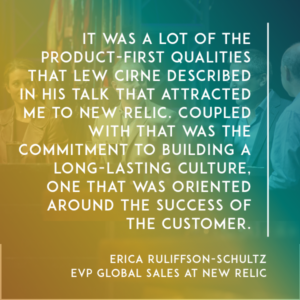
It really was a lot of the product first qualities that Lew described this morning that attracted me to New Relic. Then coupled with that, it was the commitment to culture. I was really looking for a company that was very committed to building a long lasting culture and one that was oriented around the success of the customer. New Relic had all those things.
Jason: In the process of getting, to convince to join, there’s that first moment where you first fell in love. What was the moment and what was happening at the time that gave you that interest to take into the process?
Erica: Lew, other than my current boss, Hilarie Koplow McAdams, who I’ve known for many years, Lew was the first person at New Relic that I met. The first question I asked him was because this New Relic was the second company that he’d started, I said, “What are you carrying forward from your first experience and versus what are you doing differently this time?”
That started a really interesting conversation that went on for a while. It was his authenticity that really drew me in and his self awareness and real…He’s very intentional about product strategy and strategy around culture. That really drew me in. I thought, “All right. That’s an important foundation.” That’s when I fell in love with the company, so to speak.
Jason: Bill, you’ve been at Marketo now for eight years, right?
Bill: That’s right.
Jason: When you joined the company, it was much smaller than New Relic was. You’re a experienced guy at Oracle, PeopleSoft. I’m sure you had lots of options. Tell us what was going through your mind that got you to consider the opportunity.
Bill: I remember talking to my wife as I looked at a bunch of companies that I was talking to. She said, “What’s special about this one?” There are three things that really jumped out of me.
Number one was I had just done this run of billion dollar companies and I wanted to be in a smaller space. Specifically, I wanted to be in a space that hadn’t been owned by Microsoft or SAP or Adobe or Microsoft or one of those big companies. I was going for a nascent space, which means little risky.
Number two was I wanted new technology. This is 2008. I didn’t want to go to a technology that had been developed back in ’99 because there had been so much that happened. Especially in the SaaS space. I wanted a really fresh technology and they’d just finished the product in late ’07. This is early ’08.
The third and biggest thing that really nailed it for me was I wanted to sell to sales and marketers. After my first 15 years of business, spending time selling on the IT and to manufacturing and to finance, I know that I don’t have to go learn how to talk supply chain manufacturing to sell to sales and marketers. I know the lingo. It was my people. It was my network, quite honestly.
Those three things were all met with this company and so when she said, “What’s special about this one?” I said, “It checks all three of the boxes.”
Jason: But there are a lot of marketing automation companies out there at the time that fit those criteria. What was it that made Marketo…?
Bill: The founders. I came in…I actually met with them in ’07 before they had the product done. I like to think that I’m a little bit self aware and they were recruiting for head of sales and I just didn’t know how to be a BD guy. I didn’t know how to go out to the market without having a product that was ready to sell.
I just said, “Thanks but no thanks.” They came back to me about a year later and knocked on my door when they had the product and said, “We want to show it to you.” These guys had done it before. That meant a lot to me. They’d been at Epiphany and they’d taken that company public and then they had sold that company.
They had the double stop. I said, “These guys know how to do it.”
Jason: Similar pattern for those two situations. Dave Berman, you joined Zoom recently, which we’re very happy about, being investors in Zoom. You’ve had a long track record in the SaaS space. In some ways helped create the model. What was it that got you charged up to leave a public company to go join, not a start up but a smaller, private company to go do it again?
Dave: First I’ve got to move this beer out of the way. We had our President’s Club this weekend in Cabo, Mexico. It was all inclusive and the smell is giving me a little bit of flashbacks.
Jason: Bring him some tequila.
Erica: Yeah, they’ll bring a few shots of tequila.
Dave: It’s ironic, Tequila was the song when we were walking out but I’m going to stay away from that for a long time. If we get into President’s Club.
Jason: Yeah, we will get into President’s Club.
[crosstalk]
Dave: A little bit later. I came from WebEx and WebEx, got there early on and we grew that thing and took it public and sold it to Cisco for billions and I remember telling my wife, “Alright, I’m out of this space. I want something new.” I’ll never forget the moment. I’m at RingCentral, we’re preparing our board of directors deck.
The VP of strategy’s out at the UK and I’m in our call center in Manilla. He goes, “Let’s fire up a Zoom meeting.” I’m like, “There’s no way to fire up a meeting right now.” But we fired it up and I was on mobile on a 3G network and we nailed down our board deck and I’m like, “Wow, this stuff really rocks.”
We started selling it at RingCentral and we were crushing it, off the charts with it and having a lot of fun with it, and then had some conversations with the CEO and realized how big the market was.
It was growing and we had some disruptive technology, some incumbents that weren’t catching up. I always look at the growth rate. We had 300 to 400 percent year over year growth, which is important.
Looked at the CAC, which is an important metric to see your sales and market efficiency. That was off the charts. Bottom line, the customers loved it. I did my diligence and being a customer, I knew that. It’s all about customer success.
After I joined I found out our Net Promoter Score was 62, which is unbelievable, world class. Customers really loved this stuff and the SaaS model, it’s all about usage.
Jason: Having been involved a little bit in that recruiting exercise with Dave, I can tell you, he treated that decision much like an investor. He was into all of the financial metrics and the SaaS metrics like CAC ratios and stuff.
Not only was the relationship there important but you took it down a level of granularity that I was pretty impressed with. Let’s turn the tables a little bit. Let’s pretend that you guys are founders here in the audience and you’re hiring your first VP of sales.
I know we had some discussions on an earlier panel about this but for you guys, what would be the most important thing to understand in that first or second meeting with the VP of sales, if you had to make a decision on whether to hire them or not. What kinds of questions would you be asking?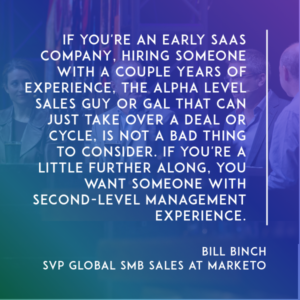
Bill: I’ll jump in. Title aside, there’s distinctly different people out there that carry a VP of sales title. You heard Sam and Emmanuelle and them speak about this morning. There are people with a couple of years of experience that are really super reps. They’re the alpha level sales guy or gal that can go and just take over a deal or cycle.
My suggestion is, if you’re an early SaaS Company, that’s not a bad thing to consider. A lot of these are folks that are probably leaving Oracles and Microsofts and want to go into a small company and have that experience.
If you are at that early stage that they talked about this morning, where you have two or three sales reps, that kind of person that comes in and sets the cadence and sets the bar, is really good.
If you’re a little further along, then they talked about people that have maybe second level management experience. Those are people that are thinking about how comp plans work, about how the hiring is going to look, about how we onboard and train our people. The answer…
Jason: At what scale? Where is the demarcation line for that?
Bill: Probably 10 reps at about that point in my mind. Like I said, I look at a lot of startup companies and a lot of the Marketo management team advises other companies, and we all trade notes.
They’ll come in they’ll say, “I want a real A+ VP of sales.” The team will go, “Well, wait is that really what you want? Do you want somebody…if you’re two reps do you want Dave Berman to go in there…?”
Jason: Overkill, right?
Bill: Yeah, that’s not what he’s probably set up to do. You’re probably looking for that up and comer and who’s going and establish him or herself to make their name in the market.
Jason: Erica, any thoughts on how would you be interviewing your potential VP of sales?
Erica: If you think about, Bill described a couple of relatively early stages. Then if you keep moving down the timeline until when you’re thinking about scale, you’re thinking about, as Bill pointed out, not just someone who can be the super rep and who can get in front of customers and close the big deals, but who can really build systems of work.
Things start to get more complicated. You have more roles in the organization. Who can think can about the who does what, and bring a little bit of science to the model. Who can attract talent? That’s huge. It’s never been harder to attract talent. What’s their reputation, what’s their network? That becomes extremely important.
Who has customer relationships? I’ve spent most of my time in the enterprise space. Maybe it’s more important there. Certainly what type of customer network might they bring to the table and how is that accretive. Those are a few things I’d look at.
Jason: Dave, you have anything to add on that?
Dave: I’d be off for best athlete and getting the best person as soon as possible because the value they can bring as a rainmaker is incredible. Getting in and learning the process, the structure and getting it set up right away for smooth sailing is really important.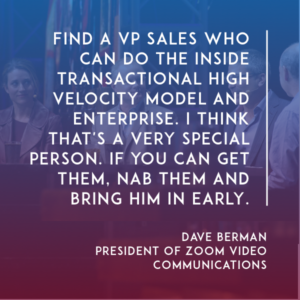
I think finding someone who can do the inside transactional high velocity model, there’s more people out there now, but finding someone that can do that coupled with the enterprise, I think is a very special person. If you can get somebody, nab them, and I’d bring him in early.
Jason: That’s a tough one to find, having looked for that a lot. You’re a VP of sales and if you’re a technical founder, you’re a couple of quarters in, there are some early results. What kind of signals are you looking for that your VP of sales is working or not working?
What, other than hitting numbers obviously, but is there anything else you guys would be looking for to give you some early warning signs, like, maybe this wasn’t such a good idea or a good fit for us?
Dave: First thing I’d do is just get aligned with the CEO on the strategy. This is what we’re going to do. It’s the multi year plan. It’s a multiyear strategy. I’m a big believer in focusing in on the vital few. What are the three or four most important things you need to do per segment of the business in measuring the shit out of those and sharing the results?
A red flag would be somebody who’s keeping the black box and won’t let you in. You want transparency. You want to know the most important things that are going on. You want to have that trust. If you’re go in there and you have a conversation with somebody who gets you all spun up and talking about all these things and you walk out confused, [laughs] that’s a huge red flag.
Jason: What about this, you don’t want to micromanage your VP of sales especially if you don’t have sales experience yourself. How do you make a balance there between knowing what’s going on and not driving you guys crazy?
Bill: Part of the answer is dependent on what kind of product do you have. If you’re selling a product like a Workday, which is a big six figure product, versus a velocity driven transaction model, if you have a transaction model, part of your score card is, are we acquiring customers?
Dave talked about the CAC, the Customer Acquisition Cost. Aside from those metrics, are you acquiring customers? Customers give your marketing team confidence that their message is hitting the mark. It gives your sales team confidence that they know how to close and can get a transaction done, and kind of, thump their chest.
It gives your customer success teams the ability to go and turn on. That feedback goes back to your development team, who says we see what our customers are absorbing. We see what they’re using and then that goes right back to the top up to marketing again on how to go out in message.
If it’s a transaction business, I think a velocity business that measuring and seeing that deals are happening is a real important thing. Not pipeline is happening, like you heard this morning. That’s a red herring for a lot of things that…
[crosstalk]
Jason: Pipeline can be manufactured.
Bill: It can be manufactured. If you’re a big company or a big deal company, I think it’s a little bit different. I think that what Erica says, are you attracting top level talent that’s been successful in the past that’s made really big W2s that come in and take a complex product and go articulate that value from a technical perspective to a business value with customers.
Erica: The other thing I would add is, and again, I’m thinking from the perspective of there’s a little more scale to the business. Often times you’re looking for, on the one hand you want someone who has the experience of running an organization at scale, but at the same time, you’re probably still at a stage where you need to know that they can get their hands dirty and have hands on the steering wheel, feel the bumps on the roads, so to speak. We were talking about this earlier. A little bit of it is inspecting like, how close are they to the business?
If you have a little bit of scale in the business, you’ve probably introduced a couple of different segments. Maybe you have an SMB versus mid market or enterprise, or maybe you’ve got customer acquisition motion versus a customer expansion motion.
“How much is the sales leader tuning the strategies to those different segments for those different pieces of their market?” I think is a good way to inspect.
Jason: Bill, maybe we’ll transition a little bit to building the early foundations of your great culture and performance in an organization. I know you joined Marketo pretty early. You talked about creating a sales cadence. Can you talk some more, what does that mean and what are the things you actually do to create that?
Bill: I got there with two sales reps, an SDR and an SC. Really pretty small. Immediately I got on the same page with the CEO, which is, what’s the mission? He’s like, “Well, we’re a money losing venture funded startup. I’m not really that sincerely caring about how much money we sell the deals for right now. I want to get customers.”
For the first year, since it was a velocity business, we were selling the SMB at Marketo, we established the quotas, not based on ARR, but on deal count. It’s just, go get the scalps. Go…
Jason: No matter what the size of the deal?
Bill: It didn’t matter. My CEO gave carte blanche to me for about three or four months, where he didn’t get in the middle of discounts, didn’t ask about them. Just at the end of the month when it was done and we did a monthly cadence, we’d sit down. We’d walk through the deals. He’d look at how we wrote them, what the discounts were, what we had committed to, that type of thing.
After about four months, he got a feeling for my style. He said, “Hey, you know, I’m gonna tighten and pull on the leash a little bit here.”
He said, “I think I need to impose some discount control,” because basically, if you could get your hands across the bar, we were serving you back then.
[laughter]
Bill: We had to cool that down a little bit to build a business that was repeatable, because we had investors like you, Jason, that were saying, “Hey, we want a return on this thing.”
Jason: The CAC isn’t very good when you…
[crosstalk]
Jason: …a hundred dollar deal.
Bill: No, it wasn’t. In a velocity business, it was about building that flywheel, that energy of getting deals done. We physically brought a cowbell into the office. You’re all on one floor. There’s…
Jason: Is it just creating this momentum, the success, basically, culture early on?
Bill: It was.
Jason: Interesting. Dave, you’ve been infamous for creating great sales cultures. I’m wondering, you just got back from Sales Club, right? We’ve got to ask about that. What happens at these things, and how do you create this energy that transitions to performance in the organization? Give us some clues.
Dave: It’s first really important to know that salespeople are motivated differently than most other people. They’re really competitive. Any time you put a trip out there, an incentive, they’re going to go after it.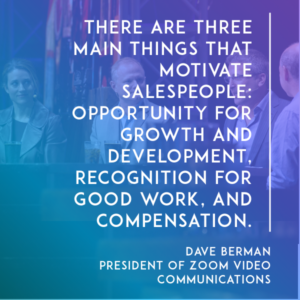
The three main things that motivate salespeople are number one, growth. Is there an opportunity for me to grow here, and learn, and develop my career? Which is super important for these millennials. You set up a career path that they can get promoted every six months.
It’s just going from a sales rep to an AE to a senior AE, but that stuff is super important.
Jason: Did you go SDR to inside sales?
Dave: SDR to sales rep.
Jason: Just a pipeline, basically.
Dave: All the way up into different segments. It’s super important that you encourage that as a leadership team. That’s how you’re going to keep people, and grow them, and really get your money’s worth.
The second thing is recognition. They love recognition. They love recognition from the CEO. Even if it’s just coming by and say, “Hey, I saw that deal. Super important for the company. Thank you.” You also should do monthly, quarterly, and annual recognition.
The annual recognition is our President’s Club. It’s a super important trip. We were just chatting backstage about bills, and the evolution of them. The first one can be Napa or Vegas. Then when you’re second one, step it up to Cabo, although all inclusive is a little rough, especially for the older executives like me.
The key lime late night tacos just don’t do so well for your stomach for multiple days, but we won’t go there. You’ve got to set it up, and encourage that. If you can get your team down there, your exec team, it’s…
[crosstalk]
Jason: What percentage of your sales team would go to an event like that?
Dave: You probably target 20 or 30 percent. It’s a high bar. Our target this year was 115% of your annual quota. The key thing about that event is making sure everybody has so much fun that they want to come back next year.
Spend time with the significant others. Get to know them. Make sure you tell them about the trip next year, which is going to be Whistler, where Bill just got back from. Very important thing. The third thing on motivation support is comp.
It’s not…People are money motivated, especially on the sales side, but if you’re doing one and two well, growth and recognition, you can middle road or 50 percent on comp. Definitely encourage the trip. Definitely pace yourself as an exec.
Jason: [laughs] Bill, you talked about some things at a prior event about creating culture between the sales organization and other folks in the organization. Could you share some lessons learned on that front, too?
Bill: There’s an old saying that came out of Disney that, when the CEO there sneezed, the rest of the company caught a cold. That applies to sales, that if sales is succeeding, it’s infectious across the rest of the organization.
If sales is not doing well, everybody else feels that. That cross collaboration to your marketing counterparts and your customer success, those are clearly the upstream and the downstream folks that you’re directly in the middle of, is super critical.
Incorporating them into the mindset that when we win, you win.
Jason: How do you do that, though?
Bill: As Dave said, sales reps tend to put 50 percent of their earnings at risk. Everybody knows that a sales rep, if they make their number, they get the President’s Club trip. They make some big accelerators. But if they miss, they’re probably eligible to get fired.
Whereas a lot of the other jobs aren’t, A, as measured in such a black and white manner, and B, it’s not as extreme that you go a couple quarters, and you’re out if you didn’t make your numbers.
From that perspective, like Dave you said, you have to motivate, and create that spirit of winning inside of the organization so that not just sales reps feel like it, but that the development team is getting credit for developing a product that’s resonating out in the market.
And that marketing is doing a great job of getting that message out there, and bringing leads to the organization that you can go and do your job, which is to sell.
Jason: Erica, what about in the enterprise, thinking about culture there? How is culture there different? You started at inside sales. Is culture different at the enterprise, big deal level? Is there anything you do differently to motivate those troops?
Erica: The difference is sometimes there’s, as Dave pointed out, I agree with his assessment of what’s important to a sales rep, sometimes in the enterprise, you will find folks who are further along in their career, and have chosen not to get on a path towards management, and move up in the organization that way.
It’s really individual, who values the development versus not, or how they weight the different pieces. Certainly, this piece of creating a culture where, as you said, the rest of the company feels the sales success, that’s so powerful. Definitely infectious.
We, particularly in the enterprise, it is a team sport. We’re often times showing up to a customer with members of the product management team, or we have engineers involved. We work really hard to be very inclusive in our recognition.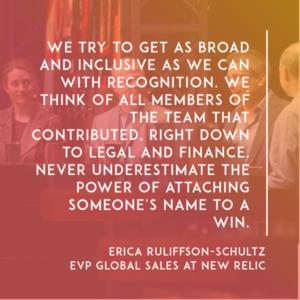
Whenever we’re holding up that great win, or that great deal, we try and get as broad as we can with the recognition. Whether it’s quarterly awards events, or the emails, or chatter posts that go flying around, we try and really think of all members of the team that contributed, down to legal and finance, and be really inclusive.
Never underestimate the power of attaching someone’s name to a win. It goes a really long way.
Bill: I think it’s important, too, in the enterprise because they’re out there on the island. You’ve always got to make them feel part of it, as Erica said. We just lost one of our field reps. He wasn’t a great performer, so it was OK.
Jason: Good. Glad to hear that.
Bill: Yeah, it’s an investor.
[laughter]
Bill: The feedback was…
Erica: You moved him out, right?
Bill: Right. He felt out there by himself. We just hired a new VP of Enterprise Sales. He sits down the hall from me. I hear him talking to everybody every morning. He checks in on everybody, makes them feel inclusive.
We also have started bringing people in a little bit more so they can feel the vibe and the infectious. We used to joke, “When you’re an inside sales rep, and you’re having a bad day, you make 30 more calls. When you’re in the field, you go out and mow your lawn.” We don’t want our guys out mowing their lawn in the afternoon.
Erica: [laughs] That’s a really good point. Most of my team’s distributed. It’s interesting, because prior to us spinning up the enterprise team at New Relic, all of the company was based in San Francisco or our engineering office in Portland. We’ve really had to work hard to help our enterprise folks feel part of a culture and part of a team.
I always think about whenever we’re pushing out messaging, communications, training, whatever it is, I think about, “OK, the field rep who’s in his home office in Columbus, Ohio, and he’s having his morning coffee. Is this resonating, and is he really getting the message, or feeling the recognition?”
That’s a really important distinction. The hub-based, or the inside sales versus the field based, there’s different considerations.
Jason: One of the things that makes you guys so unique is you’re not just great at selling, and attracting salespeople, and motivating them, but you’re great at building the foundation to scale. Dave, maybe we’ll start with you on this one, but you’ve done this a number of times.
How are you thinking about building out the organization at Zoom? What have you learned, and what are the things that you’re really, really focused on getting right to make sure you can scale?
Dave: Coming out of ADP early on, it was actually a huge company. This was 20 years ago. The major account and the SMB team didn’t get along. Marketing did whatever they want at corporate, and support and sales hated each other.
I’m sure they’ve changed by now, but in the SaaS model, that ecosystem is so important from initial opportunity through upsell, and having everybody aligned around the overall customer success is really huge.
The key is common goal alignment, and compensation on the most important metric, which IMRR, your Incremental Monthly Subscription Revenue, which is new sales, plus upsell, less churn.
Jason: Less churn.
Dave: Having everybody really focused in on that, and then…
Jason: You dock your salespeople if you have churn, basically?
Dave: We have a different team that handles that, but yeah, we do clawbacks for reps. We have a farming team. We’ve got land and expand. Land, get the customer, get them rolling. Hand them off to a farmer, so to speak.
They’re in charge of growing. They also have a churn quota. They’ve got the net number that they’ve got to measure to. The big thing is aligned around that, creating the formula. What is the math equation? Sub 500, it’s pretty easy to get it down to a science. Above that, it’s a little bit more hard.
Jason: For each segment, there’s a different strategy?
Dave: There is a different strategy for different…
Jason: How many different segments do you have, and how different is it, in terms of…?
[crosstalk]
Dave: We just went from three to four. What we did is we aligned our sales segments around our customers’ buying process. A lot of you guys may have heard of the buyer’s journey. You want to sell to your customer how they’re buying.
We interviewed close to 50 of our customers, and found out how they bought. Now we’re in the process of aligning that sales process to it. You’ll find the natural break points of where the process changes.
Jason: How would you characterize those four segments? Just self service, inside sales.
Dave: We’ve got a “just me” segment, which is pretty much online. We’ve got an SMB, we’ve got a mid market, and we’ve got a large account sales process. It’s very different strategies, very different tools, different metrics. Very important.
Jason: You’re setting up four different sales organizations, in essence, simultaneously?
Dave: Correct.
Jason: That sounds complicated.
Dave: It’s not.
Jason: No? How about you, Erica? How are you thinking about segmenting the organization? You’re focused mostly on enterprise, but is there named accounts, strategic accounts, and then geographies below that?
Erica: At New Relic, we have two broad segments, SMB and enterprise. Within each of those broad segments, we have three sub segments. In SMB, for example, you’ll start at the low end of emerging small business up through mid market
Then in the enterprise space, we have a commercial team, an enterprise team, and strategic account territory. Each one is slightly different, so it does get complicated. You certainly look for what can be common across those segments.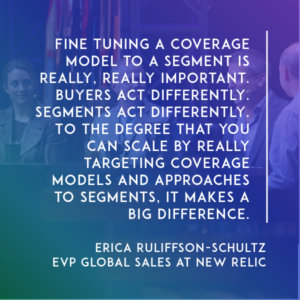
Fine tuning a coverage model to a segment is really, really important. Buyers act differently. Segments act differently. To the degree that you can scale with really targeting coverage models and approaches to segments, it makes a big difference.
Jason: Bill, how important is sales operations? What does that mean, and who provides that capability? Can you explain what that means?
Bill: Super critical. I’d break it into a couple categories. There’s operations, which to me, is the team that helps you quote, that helps you configure the deals, that when it comes in books, they’re the ones that help you process, and put the deals through for approvals, and workflow, and things like that.
That team’s critical, because in an early stage company, you typically don’t have that. Which means it’s a sales rep doing it. Which means time away from making the 30 extra calls that Dave said, or from working on that next demo, or whatever.
It’s one of the things that I’m a big advocate of, that in any size company, as soon as you feel like you can afford it, to put it in there. The other half of it is…
Jason: How expensive is it? How many people is involved?
Bill: Everything is an opportunity cost. You go grab a $60,000 $70,000, $80,000 sales operations person. You’re like, “That’s an SDR or that’s half of sales rep that I could have had.” I would rather put the dollar there.
Jason: Right. Or if it makes everybody else more productive in the organization, that’s…
[crosstalk]
Bill: That’s the point. Like Marketo, our first year, we didn’t have renewal reps, because we didn’t have any renewals. Then I hit the one year mark and all of a sudden, we started having renewals. I was paying my sales reps to do it, which means, they were looking at new business, which is what they’re focused on.
I’d call them up on the 31st of the month and say, “Where are the renewals?” They’d be like, “Oh, I’ll make those calls now.” So they were slipping.
Finally I looked and calculated up what our renewals book of business looked like, and said, “I can afford a renewals rep for the fees that I’m paying these guys, and they’re not even chasing it. I can afford one.”
There’s also sales training and sales enablement. That’s the other half of sales operations. That’s one that our A-level investors into Marketo said to me, “Hey, you guys are doing a great job of tribally sharing the knowledge of how to sell, but you really need this.” I was like, “No, I got this. I got this.” He’s like, “You’re going to regret this.”
Literally to this day whenever I see him, I kind of give him a hug and say, “Hey, did I ever tell you that you were right?” He’s like, “You tell me every time, Bill.”
It’s true. The sales training and enablement, you can’t get that too early. As soon as you get some scale. Back to your question of how many, once you get eight, ten sales reps and you’re hiring at a rate where you’ve got one coming a month or one every other month or something like that, you as a sales leader, you’re probably running the sales, the SDR, the customer success, the SDR team.
Then all of a sudden you’re having to go train people. You have to go sit in board meetings.
Jason: What’s best in class? Getting a sales rep from scratch to being productive, do you think, in the business?
Dave: It depends on…
Erica: It depends on the segment.
Dave: It depends on the segment. In the SMB, you can do it in 60 to 90 days. Mid market, closer to six months. Enterprise, I’ve seen it go up to nine months, but we quote them at six.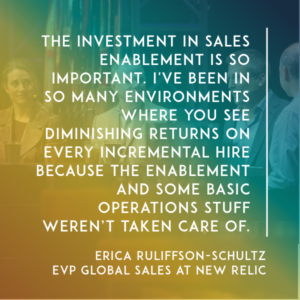
Erica: Six to nine months. Yeah. I’m with Bill. The investment in sales enablement, so important. I’ve been in so many environments where you see diminishing returns on every incremental hire, because we haven’t taken care of the enablement and some of the basic operations stuff. So the right investment in that goes a really long way.
You have to make sure those folks are really productive and really effective. If they’re not, it’s a drain.
Jason: How long do you give them before you call it? Let’s say six months is the standard practice for getting them up to speed. At what point do you call it?
Dave: It depends. You got to look at the quantity and the quality. Are they putting in the calls? Are they doing meetings?
Jason: So inputs?
Dave: Right. And are they coachable? Are they learning and getting better? If someone’s coachable, and they’re doing the activities, I’ll give them an extra quarter. Maybe two if we can see the improvement, but if they’re not putting in the basics and they’re not meeting the core metrics, then…
Jason: One thing I harp on all the time as a board member is churn. Like that’s the thing I think that is the cancer for any SaaS business.
I’m curious how you guys create incentives, because you want your salespeople out there closing deals, booking business and focused on new, but at the same time, you got to make sure that they’re successful customers and hopefully land and expand opportunities. We’ll have a whole panel on land and expand after this.
Can you talk a little bit about how you create some balanced incentives there?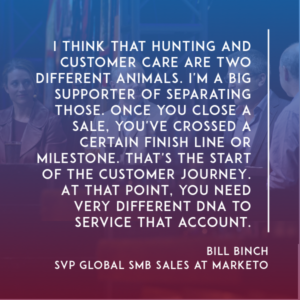
Bill: This is personally speaking, but I think that hunting and customer care are two different animals. I’m a big supporter of separating those, because I do think that you get people that…look, you don’t come out of the oven as a sales rep, as a great prospector.
You go hire John Barrows, who’s here. He comes help you learn how to go message and get reaction from customers. You learn how to sell. You learn how to build value inside these organizations.
Then you go close that, and you’ve crossed a certain finish line, a certain milestone. That’s the start of the customer journey. At that point, there’s a very different DNA in my mind that goes on servicing that account.
I’m a personal believer that I like hunters. Their mission’s clear. I go get the account and I close it and I try to obviously maximize the ARR, because that’s probably going to benefit me from a commission. It’s going to benefit the company. Then I’m going to hand it to a team that’s a professional…
Jason: So you just throw it over the wall to somebody else?
Bill: Most companies have a workflow transition.
Jason: But how do you make sure that they’re not closing business that ultimately isn’t good business?
Bill: In a SaaS company that’s under 30 people, you’re probably all sitting on the same floor. Your development’s there with your marketing and your sales.
Today, most floor plans you walk out to, they’re open floor plans. They hear you, what you’re saying on the phone. So when you hang up, there’s this real-time coaching that happens. It’s not always from the sales team. It’s sometimes from the developer, like saying, “What did you just say? What did you just commit to? Because we don’t do that.”
There’s a very realistic aspect of how a transition happens like that inside an organization. Look, most big…like Zach Nelson, who’s here…he has a whole professional customer success team that measures net promoter score and lifetime value and things like that that a sales rep’s just not thinking about.
Jason: Erica, any thoughts particularly on the enterprise, where sometimes they’re asking for things that may not be on the road map ever or in the near term? How do you balance those opportunities?
Erica: Yeah. I’ll answer that, and then I want to get back to the churn question, too.
You have to be really careful. Lew alluded to this a little bit this morning, that it’s a fine balance in the enterprise space between staying true to your vision, but also taking customer feedback and making customer specific commitments as a general rule, we look for patterns and if it makes sense for a category of customers, then it gets consideration, but I think it’s a fine balance.
A lot of companies have gotten in trouble by chasing every little request that comes in from different enterprise customers.
On the churn question, it’s so important. We’re maniacally focused on it at New Relic. We’re really fortunate that we have a great net expansion rate.
Jason: Yeah. You said it was 129 percent growth over your…like that…
Erica: 129 percent last quarter.
Jason: That’s a beautiful thing in a SaaS model.
Erica: It is. It’s kudos to a product that customers love. A really viral adoption model, which really serves us well.
We’ve toyed with both models of acquisition versus account management. We’ve tended to blend them in many segments only because there are perils to the hand off of the acquisition rep over to the account management rep.
Because we have a product that does virally expand so well within our customers, we found that the individual who puts the work in to acquire the customer, we see that oftentimes they’re the best suited to continue the relationship and continue the selling.
So it depends on the market segment and the state…
Jason: You don’t have the hunter/farmer kind of distinction?
Erica: Not in most markets. In some markets, we do.
Bill: Also, just a clarifying point. To me, I separate cross sell back to the customer – I think that’s a selling motion. Renewals and customer care is a different…
Jason: Good point, yeah.
Bill: Now in big accounts, it does tend..look, you spend 6, 9, 12 months selling a deal. You don’t want to pull that person right out. So that’s a fair point. You do want that person in there, but there is, to me, a distinction of cross selling versus renewing.
Erica: Yeah. We have a dedicated renewals and customer success team, but we also have…every AE is also incented to make sure that the renewals come in.
Jason: Dave, how do you deal with it?
Dave: The first leading indicator of churn is usage. You’re going to look and see why your customers are leaving. But usage is your leading indicator. That’s the most important metric.
A couple things you can do. We’ve had success putting customers on multiple year agreements. At the right time, not jamming them when they’re in the pilot stage, but really that’s the best way to do it.
The second thing that we’ve done really well is create save teams.
Jason: Save teams?
Dave: Save teams. Somebody who’s dedicated to…
Jason: Like SWAT teams, basically?
Dave: It’s a reverse salesperson who does whatever they can to save that account. It’ll take a lot of the heavy lifting off your up sell team.
Jason: So they look at some of the engagement maybe, and then if it’s low engagement, you send in the SWAT team basically?
Dave: Send in the SWAT or try and get ahead of it. Get some key uses there.
The last thing is just aligning all the management in the company on that net MRR, which includes churn. This is really important. So everybody’s aligned to it.
Jason: We have only a couple minutes left here.
I would love your guys’ thoughts on where things go from here. Like are there any major changes? Clearly, the world has changed a lot in enterprise software and SaaS and cloud. What do you see over the next few years? Will we ever see reps generating multiples of the quotas they’re generating today. Like what would enable that to happen? Is there any order of magnitude changes you could see coming down the pike?
Dave: We do a good job now with the sales tools. Being able to look at quantity when people are touching things. How often customers are opening your emails. Looking at all that stuff.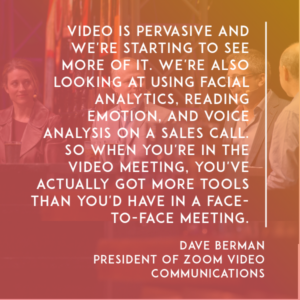
What I get pretty excited about is the quality stuff. How can we help salespeople be better? Video is pervasive, and we’re starting to see more of it. We were just talking about how my peers up here are using video in more of their sales calls.
We’re looking at doing stuff about facial analytics, reading emotion, voice analysis on the call. So when you’re actually in the video meeting, that you’ve got more tools than you actually have in a face to face…
Jason: So real time, you could…
Dave: Real time, big data, kind of next gen…
Jason: So you’re ticking this person off, basically? It’ll tell you basically you’re heading down the tubes.
Dave: Pretty much. This is where everybody dropped. Your joke bombed here or you lost everybody at this point. Most importantly, using that as a teaching and coaching moment.
Bill: Lew said something really important this morning when he talked about the first 90 seconds of being with an iPhone. That it used to be this. You have to be in the store and sit there for half hour while they configured your phone.
You talk about how that’s applied to software. You’re seeing it happen, because ten years ago, maybe 15 years ago was the start of trials and freemium models where you could go and self provision.
Can you imagine if you opened up a Facebook account and it took you 60 days to get that live? You’d never use it. They would never have adoption, but you see that in the Internet world, and I think as you apply to the business to business or B2C selling side, there’s a real effort on trying to make the software more consumable like Lew said.
Erica: With that, it puts pressure on any sort of sales individual or go to market role to have that much more subject matter expertise. Because your customer can get to first base without you. They’re much more educated. They’re probably already using your product before they even speak to you.
We’re really focused on…and ours tend to be a fairly technical sale, but making sure that our teams have really strong subject matter expertise, so that we’re able to add a lot of value in every interaction.
Jason: I think it was Lew that talked about creating frictionless experience for the customer. To me, it’s like designing for lack of friction and getting to success for salespeople. If more people thought about the entire process like that, I think we’d all be making those big investments much more productive.
Thank you guys for joining us today. It’s been awesome. We could talk all afternoon, but…
